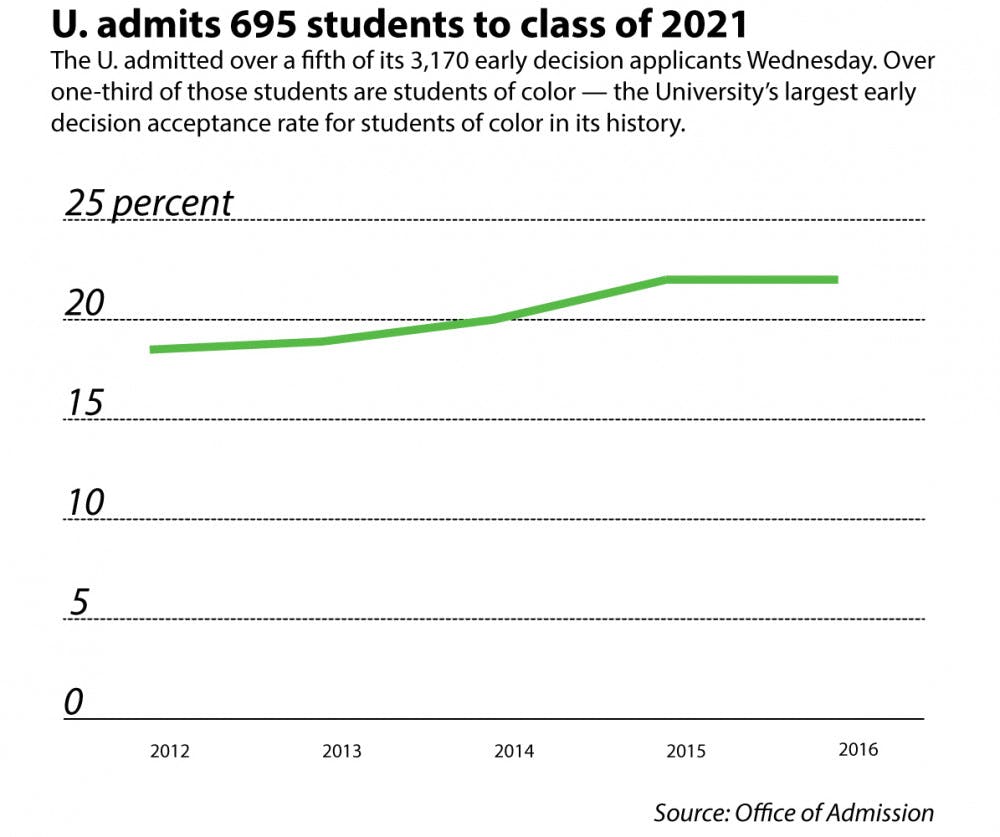Updated Dec. 15 at 11:35 p.m.
The University accepted 22 percent of its early decision applicants to the class of 2021, offering spots to 695 students — the largest number of students ever admitted early decision.
The accepted applicants were chosen from the University’s largest early decision applicant pool of 3,170 students. Sixty percent of the applicants were deferred and 18 percent were rejected, said Dean of Admission Logan Powell.
The University has witnessed a steady increase in the number of students accepted early decision over the past few years. The University accepted 22 percent of early applicants to the class of 2020, 20 percent to the class of 2019 and 18.9 percent to the class of 2018, The Herald previously reported.
The Program in Liberal Medical Education accepted 21 students out of its 312 early decision applicants — an acceptance rate of 6.7 percent, similar to that of the class of 2020.
“If we're looking at this as a milestone in the progress that we make in the course of the year, this group is representative of all of our priorities,” Powell said, adding that the class of 2021 is not only academically gifted, but also the largest and most diverse early decision class in the University’s history.
Of the 694 admitted students, 411 checked off “female” and 284 checked off “male” on the Common Application question that asked applicants what sex they were assigned to at birth, Powell said.
The Common Application was modified this year to allow students to elaborate on their gender identity, he said, adding that “there are students who would say they don’t identify along the gender binary and would put additional information.”
Fifty-three percent of admitted students intend to apply for financial aid, which is another record-breaking statistic, he added.
Of admitted students, 36 percent identify as underrepresented racial minorities — the highest in University history. Last year, URMs comprised 31 percent of the early decision applicant pool for the class of 2020.
Powell was particularly enthused by the number of admitted students who will be the first in their families to attend Brown. First-generation college students comprise 13 percent of the early decision class, which is nearly double the percentage of first-gen students from the early decision class of 2020.
“That’s the piece that really stood out to all of us,” Powell said. “It was such a remarkable growth in the number of applicants.”
Admitted students come from 39 nations and 41 U.S. states, Powell said. The most represented U.S. states are New York, California, Massachusetts, New Jersey and Connecticut. China, Canada, Singapore, India and the United Kingdom are the best-represented foreign countries.
“Everyone at Brown seemed so happy and seemed to love learning so much,” said Zoë Mermelstein ’21 of Westchester County, New York of her visit to campus. Mermelstein is thinking of double concentrating in classics and Middle East studies. After Mermelstein emailed the Middle East studies department expressing her interest, “they rolled out the red carpet” for her when she came to campus and paired her with a student representative who shared his love for the University with her, she said.
“I was really drawn to the open curriculum and the pass/fail grading system,” said Grace DeLorme ’21 of Washington, D.C. The University also fosters an “intellectual experimentation” that appeals to her because she is undecided on what she wants to study.
Powell noted that nearly 60 percent of the class of 2021 will be admitted from the regular decision applicant pool and it is “far too early to declare victory,” he said. But the admission office will continue to do its best to assemble a talented, diverse and intellectually-engaged community in the months to come, he added.
“We don't admit students because they represent a certain part of a profile, we admit students because we have faith they will do exceptional things here and after they graduate,” Powell said.

ADVERTISEMENT




